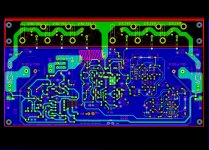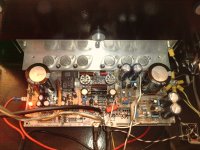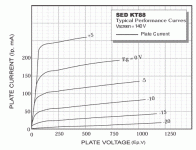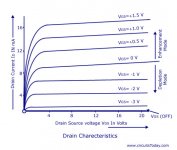Diet
😛 That's healthy! Good iron intake 😀
Can you burp up some mosfets?
According to my bank manager, there's plenty left.
Some of my neighbors think I'm on a numismatist diet.
😛 That's healthy! Good iron intake 😀
Can you burp up some mosfets?

Member
Joined 2009
Paid Member
Even in a physics forum - 😀 https://www.physicsforums.com/threads/why-is-fet-voltage-controlled-and-bjt-current-controlled.335368/
OS
It's a confusion that goes back a long way, but if you really dig into it you will find that all active devices are voltage controlled at heart - they need a control voltage to be applied across two inputs (base-emitter, grid-cathode, gate-source...).
Both BJT's and FETs need to be driven from a voltage source that can supply sufficient current to maintain the voltage at the control input - for a FET the current is needed to charge/discharge the gate capacitance. Because of this finite input impedance the signal voltage source has to be able to provide current but this current is a parasitic property, it's a consequence of an imperfect device.
Looking at the usual physics describing a BJT we usually see that the current flow depends exponentially on Vbe (not the base current flowing through the base-emitter control inputs).
You can drive the base with a current input (high impedance source) - what then happens is this current develops a voltage drop across the impedance of the control inputs (base-emitter) and that voltage drop is the control input that determines the current flow through the collector...
Hi Bigen,
Your argument is very nice.But sorry to tell you that it is wrong.In a linear ckt when voltage varies current also varies and vice versa.
But the question is who controls the output parameter(current),input voltage or input current.
BJT is called current controlled device because the output parameter Ic is varying inaccordence with input current Ib not with Vb.you cannot define Ic inaccordence with Vb.
But in the case of FETs or Vaccum tubes Output current varies in accordance with gate or grid voltage not with gate or grid current.So these devices are called voltage controlled devices
In other words you can relate Ic with Ib.That is known as gain of that BJT.
Ic=Ib x Beta, beta is a constant. From the equation Ib is the control variable
In the case of FET equation is not this much straight and simple.But
Id=Idss(1-vgs/vp)2 , Idss and Vp are constants.So Id varies in accordance with Vgs. So Vgs is control variable
Best regards
Joshvi
Your argument is very nice.But sorry to tell you that it is wrong.In a linear ckt when voltage varies current also varies and vice versa.
But the question is who controls the output parameter(current),input voltage or input current.
BJT is called current controlled device because the output parameter Ic is varying inaccordence with input current Ib not with Vb.you cannot define Ic inaccordence with Vb.
But in the case of FETs or Vaccum tubes Output current varies in accordance with gate or grid voltage not with gate or grid current.So these devices are called voltage controlled devices
In other words you can relate Ic with Ib.That is known as gain of that BJT.
Ic=Ib x Beta, beta is a constant. From the equation Ib is the control variable
In the case of FET equation is not this much straight and simple.But
Id=Idss(1-vgs/vp)2 , Idss and Vp are constants.So Id varies in accordance with Vgs. So Vgs is control variable
Best regards
Joshvi
Member
Joined 2009
Paid Member
Even in a physics forum - 😀 https://www.physicsforums.com/threads/why-is-fet-voltage-controlled-and-bjt-current-controlled.335368/
OS
The first page alone has several nonsense comments. The Vbe equation IS the basic physics of a BJT.
Hi Bigen,
Vb.you cannot define Ic inaccordence with Vb.
NO, NO NO, NO. The Vbe sets the Ic exactly beta has nothing to do with it. Eq. 2 attached. Why does this nonsense keep coming up?
http://users.ece.gatech.edu/mleach/ece3050/notes/bjt/thebjt.pdf
Hi Scott,
I am agreeing with you.But what I tried to tell is that you can write a linear function between Ic and Ib if the transistor operate in active region (amplifier mode).
Ic=Ib X Beta, neglect the leakage currents. So Ic is propositional to Ib
But the equation no2. (your attachment)is not linear function between Ic and Vbe.it is an exponetial function.So you cannot say change in Ic is propositional to change in Vbe.
Our discussion is why BJT is called current controlled devices and FET voltage controlled devices.When Vbe varies Ib also varies and vice versa.So either change in Vbe or Ib will change Ic.
But change in Ic is linearily related to change in Ib but not linearily related to change in Vbe.
So BJT is called current control devices.
BR
Joshvi
I am agreeing with you.But what I tried to tell is that you can write a linear function between Ic and Ib if the transistor operate in active region (amplifier mode).
Ic=Ib X Beta, neglect the leakage currents. So Ic is propositional to Ib
But the equation no2. (your attachment)is not linear function between Ic and Vbe.it is an exponetial function.So you cannot say change in Ic is propositional to change in Vbe.
Our discussion is why BJT is called current controlled devices and FET voltage controlled devices.When Vbe varies Ib also varies and vice versa.So either change in Vbe or Ib will change Ic.
But change in Ic is linearily related to change in Ib but not linearily related to change in Vbe.
So BJT is called current control devices.
BR
Joshvi
Member
Joined 2009
Paid Member
Actually, beta is not constant and follows a behaviour that is more complex than a simple exponential.
The existance of a relationship between Ic and Ib does not imply one controls the other. Without an applied control voltage there will be no Ic. Ib is incidental. It is a voltage controlled device. BUT if it does no harm for you to think otherwise then in matters not.
The existance of a relationship between Ic and Ib does not imply one controls the other. Without an applied control voltage there will be no Ic. Ib is incidental. It is a voltage controlled device. BUT if it does no harm for you to think otherwise then in matters not.
Actually, beta is not constant and follows a behaviour that is more complex than a simple exponential.
The existance of a relationship between Ic and Ib does not imply one controls the other. Without an applied control voltage there will be no Ic. Ib is incidental. It is a voltage controlled device. BUT if it does no harm for you to think otherwise then in matters not.
As it is right, it is still base emitter current that controls Ic. Also, in real life circuits, in view of tolerance minimizing, emitter resistor is added for negative feedback. This resistance is reason why voltage becomes important when driving common emitter circuits.
And why "current controlled devices"? Maybe because of internal process. Current Ib changes barrier on cb pn junction and it reflects on Ic.
http://www-inst.eecs.berkeley.edu/~ee130/sp03/lecture/lecture15.pdf
It is little different when voltage controlled devices are in question. There is gs voltage that controls field through FET ( P or N) channel. Higher voltage, smaller barrier, higher current.
http://www.ece.ucsb.edu/Faculty/rodwell/Classes/ece2/note/set_2_active_devices.pdf
Member
Joined 2009
Paid Member
And why "current controlled devices"? Maybe because of internal process. Current Ib changes barrier on cb pn junction and it reflects on Ic.
http://www-inst.eecs.berkeley.edu/~ee130/sp03/lecture/lecture15.pdf
I read through the lecture carefully. I see a voltage controlled device. The current flow is dependent on the boundary conditions at the PN junctions (e.g. look at the analysis of the base region). Such boundary conditions are determined by applied voltages. You can see the Vbe dependency spelled out clearly.
I read through the lecture carefully. I see a voltage controlled device. The current flow is dependent on the boundary conditions at the PN junctions (e.g. look at the analysis of the base region). Such boundary conditions are determined by applied voltages. You can see the Vbe dependency spelled out clearly.
Bigun maybe you have more energy for this discussion, but I have learned THEY DON"T GET IT.
Bigun,Don't run between cutoff and saturation region,best to sit( bias) at centre of active region.🙂🙂🙂🙂🙂
How output characterstics of BJT Ic Vs Vce ploted .Go to any manufacturers website.It is Ic vs Vce keeping constant Ib.If you change Ib you will get different plots.
In the case of FET it is Id Vs Vds @ constant Vgs.
Then why they are not plot Ic vs Vce @ constant Vbe?
BR
Joshvi
How output characterstics of BJT Ic Vs Vce ploted .Go to any manufacturers website.It is Ic vs Vce keeping constant Ib.If you change Ib you will get different plots.
In the case of FET it is Id Vs Vds @ constant Vgs.
Then why they are not plot Ic vs Vce @ constant Vbe?
BR
Joshvi
Transistors are not linear devices over wide operating conditions.We are using transistor as an amplifier in the linear region only.By keeping the transistors in linear region(called biasing) and if the opreating conditionis is small then beta is almost constant.
Member
Joined 2009
Paid Member
Bigun maybe you have more energy for this discussion, but I have learned THEY DON"T GET IT.
I know, it's one of those things where it takes a lot of gas to get people on the right path.
Last edited:
. . . and not helped by countless introductory text books over the decades stating that BJT's are current controlled devices, or graphs with titles that included " . . . . showing the dependency of Ic on Ib . . ." or the tap analogy (the base is the tap handle, as it is turned more water - i.e. Ic - flows)
Output characters of BJT,FET and Tubes are attached .From that you can see what are VC,CC devices.why they are called So.
BJT - IC Vs Vce @ constant Ib
FET - Id Vs Vds @ constant Vgs
Tube - Ip Vs Ep @ constant Eg
BJT - IC Vs Vce @ constant Ib
FET - Id Vs Vds @ constant Vgs
Tube - Ip Vs Ep @ constant Eg
Attachments
I read through the lecture carefully. I see a voltage controlled device. The current flow is dependent on the boundary conditions at the PN junctions (e.g. look at the analysis of the base region). Such boundary conditions are determined by applied voltages. You can see the Vbe dependency spelled out clearly.
You just see it from different point of view.
Think like this: BJTs have very small base emitter resistance when voltage exceed cca 0.6V barrier (approx. 0.026/Ic ohm) and can not be driven by voltage source directly because of overcurrent.
FETs have very high resistance even threshold is exceeded (cca 10^9 ohm). So it can not be driven by current source directly because of overvoltage.
Last edited:
- Home
- Amplifiers
- Solid State
- The Very Best Amplifier I Have Ever Heard!!!!




